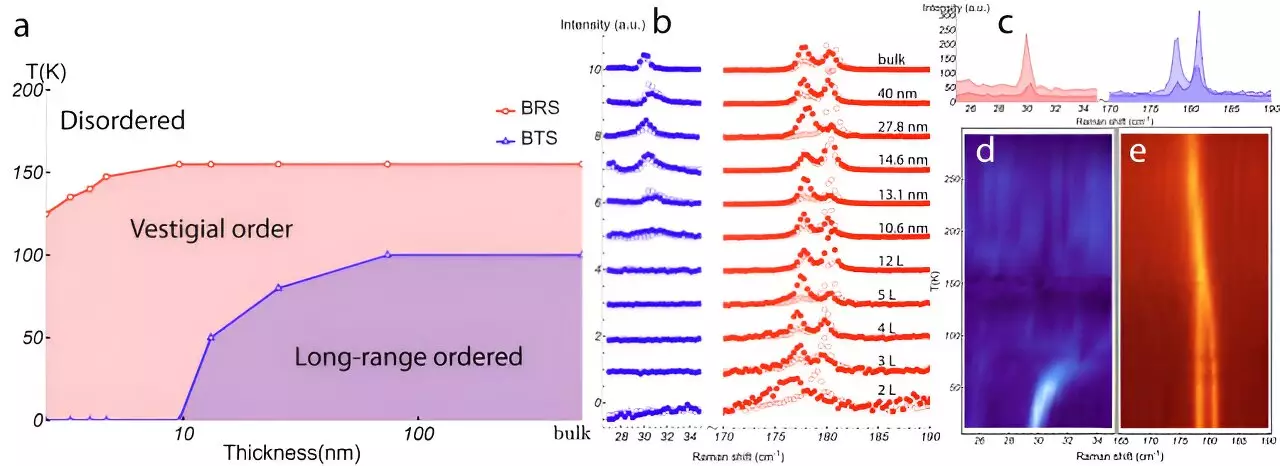Recent advancements in material science have centered around van der Waals (vdW) materials, a unique class of materials characterized by their distinct electronic and magnetic properties. A collaborative study among physicists from The University of Hong Kong (HKU), Texas Tech University (TTH), and the University of Michigan (UMich) has led to a significant breakthrough in understanding these materials, particularly nickel phosphorus trisulfide (NiPS3). This groundbreaking research marks the first experimental observation of a transition in NiPS3 from a three-dimensional (3D) long-range magnetic order to a two-dimensional (2D) vestigial order state, facilitating new perspectives on the magnetic properties of materials at microscopic scales.
The Significance of NiPS3
NiPS3 has captured the attention of researchers due to its impressive magnetic behavior when reduced to single or few-layer configurations. This property renders it a compelling subject for exploring the evolution of magnetic characteristics relative to physical thickness. The study’s findings not only aid in comprehending the control of magnetic properties in these materials but also open possibilities for technological advancements such as improved electronics and energy-efficient devices. Significantly, this research was published in the esteemed journal Nature Physics, affirming its importance within the scientific community.
Echoing a question posed by physicist Richard Feynman in his famous 1959 lecture, “Plenty of Room at the Bottom,” the study of van der Waals materials brings new relevance to the exploration of nanoscale phenomena. Feynman’s query revolved around the potential of manipulated layered structures, a notion that may have lacked attention at its inception but found a new avenue of exploration in the context of burgeoning nanotechnology. The layered structure of vdW materials, like NiPS3, invites intricate investigations into material properties, championing discoveries that could redefine technological landscapes.
Understanding Symmetry Breaking in NiPS3
A pivotal concept in condensed matter physics, symmetry breaking defines the changes in material states influenced by variables such as temperature and layered configuration. The research team specifically focused on the intermediate symmetry breaking observed in NiPS3, which transitions from a primary magnetic order to a vestigial order as the material becomes thinner. Unlike conventional symmetry breaking, which entails the loss of all symmetries, vestigial order involves selective symmetry retention—a nuanced phenomenon that had largely remained theoretical until now.
To elucidate the dynamics of NiPS3 and capture the vestigial transition, the researchers employed advanced experimental techniques. By utilizing nitrogen-vacancy (NV) spin relaxometry and optical Raman quasi-elastic scattering, they meticulously evaluated the melting of the primary order and monitored the emergence of vestigial order during the dimensional shift. Furthermore, large-scale Monte Carlo simulations provided substantial insights into magnetic phase transitions, thereby allowing the team to visualize the distinct behaviors of NiPS3 under varying dimensional constraints.
This dual approach—combining experimental observation with computational simulation—has set a new benchmark for material studies and illuminated the complex interplay between 2D and 3D physics. The detailed tracking of symmetry transitions reinforces the foundational concepts of condensed matter physics and showcases the fascinating behavior of NiPS3 as a case representative of broader phenomena.
The research team’s revelations lay the groundwork for future exploration into layered materials. As the field progresses, multilayered structures like graphene and NiPS3 could spearhead innovations in flexible electronic devices, low-power memory circuits, and energy-efficient computing solutions. The ability to engineer material properties at the nanoscale heralds a transformative phase in electronics, fostering the development of lightweight, adaptable, and high-performance devices.
These advancements resonate with Feynman’s original vision, steering the scientific community closer to realizing the multi-layered materials envisioned 65 years ago. By harnessing the properties unlocked through vdW materials, there exists an exciting horizon filled with potential applications poised to reshape our technological landscape.
The collaborative efforts of researchers in studying NiPS3 and its unique magnetic properties have resulted in groundbreaking insights that could have far-reaching implications for technology. The bridging of experimental technique and theoretical exploration reveals a landscape rich in potential for developing new electronics and computational devices. As we take pivotal steps forward, our understanding of van der Waals materials may very well redefine the possibilities for the future, fulfilling the tantalizing promise of layered structures that Feynman so eloquently envisioned.


Leave a Reply